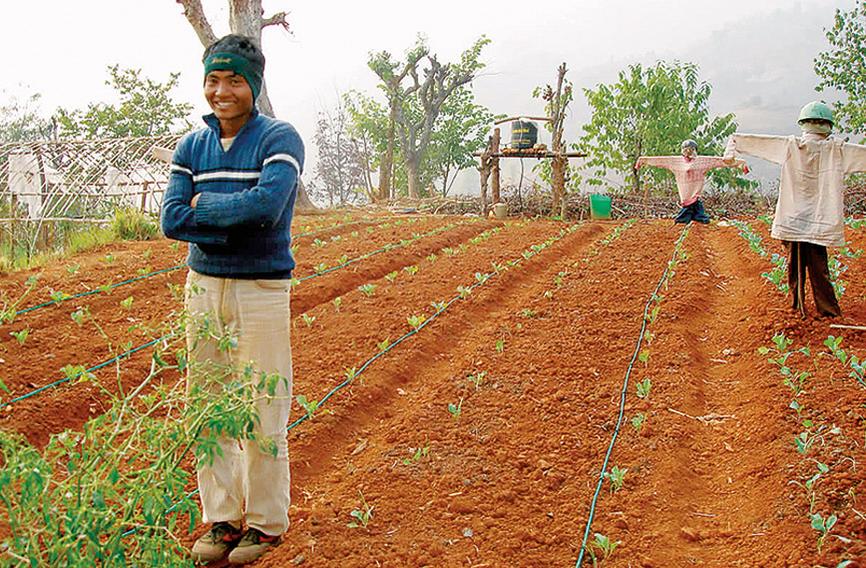
SANTOSH MEHROTRA
For some years now, surveys have indicated that a significant proportion of farmers want to give up farming. Underlying this phenomenon are two contradictory trends. One is the distress of the poorest, the small and marginal farmers (those who till less than two hectares and form 85 percent of cultivators), and, to some extent, the rural landless labour (who accounted for some 30 percent of India’s 220 million workforce in agriculture in 2012).
At the micro level, for the small, marginal farmer, when the crop fails due to unseasonal rain and if he is indebted, his situation becomes hopeless. If he also happens to be a share-cropper and not an owner-cultivator, and is then indebted (especially to moneylenders), hopelessness can lead to suicide when the crop fails.
At the macro level there are two positive forces at play in agriculture. First, it was only after 2004-05, when the GDP growth rate (including agriculture) rose sharply, that for the first time in India 37 million workers left agriculture in the seven years leading up to 2011-12. While the share of the workforce in agriculture had been declining prior to 2004, investment in construction grew rapidly between 2004-05 and 2011-12, leading to landless labour leaving agriculture to become construction workers. A Lewisian structural shift had begun.
The second path-breaking development was that for the first time in India’s history there occurred an absolute decline in the numbers of the poor as real wages rose rapidly. While poverty incidence declined by 0.7 percentage points per annum between 1993-94 and 2004-05, between 2004-05 and 2011-12 it tended to decline at over double that rate (at 2 percentage points). However, further hastening the rate of poverty reduction will be crucially dependent upon the fortunes of agriculture (both crop and non-crop).
In post-independence India the growth rate of agriculture has rarely exceeded three percent per annum, and even then it has barely risen above three percent. Hence we cannot claim that there has been an agricultural revolution in India, despite the Green Revolution in the 1970s and ’80s. East Asia achieved a six percent growth rate in agriculture between 1950 and 1980.
Lessons from Gujarat
The Indian paradox is that mechanisation is occurring in agriculture and rural consumption is rising, but farm yields are growing too slowly. The government could have taken action to benefit farmers by simply learning from Gujarat’s success in agriculture.
Increasing crop yields requires that inappropriate use of fertiliser — arising from the market-distorting and soil health-destroying fertiliser subsidy to manufacturers — is put an end to quickly and replaced by cash transfer to farmers. But the government has only recently shown signs of fertiliser subsidy reform, other than advocating that each farmer should get his soil tested and maintain a soil-health card (as is done in Gujarat). Raising yields also requires the rapid rejuvenation of the farm extension system, whereby extension workers help the farmer with new knowledge.
The agricultural research and extension system had deteriorated in Gujarat, as in the rest of India. But, after 2000, the Gujarat government unbundled the massive Gujarat Agricultural University into four independent universities and increased the resources allocated to them. Scientists at the four universities were then mobilised to rejuvenate the moribund ‘training and visit’ extension model. Partly due to extension work, farmers in Gujarat have shifted en masse from a 13:7.5:1 nitrogen-phosphorus-potassium composition in fertiliser use which was harmful to crops and soil, to a 6.5:3.5:1 composition, thus reducing cost, increasing production and improving net income.
Raising crop yields also requires better management of water and pricing of electricity for farms. In both Gujarat has shown the way – which partly explains why the state experienced a growth rate in agriculture that is at least twice (about 6.7 per annum) the national average, despite being semi-arid. While excessive groundwater use in the grain belt of Punjab and Haryana has caused a serious fall in the groundwater table there and elsewhere in India, Gujarat’s government, in contrast, supported farmers in undertaking decentralised rainwater harvesting and groundwater recharge work. This started as a mass movement.
Second, the government popularised micro-irrigation (sprinklers, drip irrigation) to prevent inefficient use of water, common all over India. While the UPA government underfunded the subsidy for sprinklers/sprayers/drip irrigation, which requires capital investment by farmers, the Gujarat government developed a subsidy-loan programme which is by far the best offered by states to adopters of micro-irrigation. As a result, the spread of micro-irrigation is more rapid in Gujarat than other states. To be fair, the 2015-16 Budget did introduce the Pradhan Mantri Gram Sinchai Yojana to provide ‘per drop more crop’.
Gujarat’s approach to power supply for agriculture also offers lessons for other states. All over the country, electricity is in short supply, including for agriculture. Yet, most Indian states charge a subsidised flat tariff for farm power supply. But Gujarat ensured quality power supply for limited hours, for which farmers were willing to pay.
Raising farmer earnings also means whittling down middlemen. That requires reform of APMC (Agriculture Produce Marketing Committees) Acts. Gujarat was among the early states to amend its APMC Act to enable farmers to directly sell their produce to wholesalers or exporters, without having to operate through arhtiyas or commission agents. The amendment also enabled conditions that encouraged the spread of contract farming. The government encouraged large corporates to establish retail chains and source their produce directly from farmers.
Next was diversification into non-crop production. Gujarat has been a leader in milk production in the country (due to its rural road network) since 1970 and offers lessons for the rest of India. Since rural roads are now in place in most of the country, there is need to extend beyond crops to livestock and fisheries. What is holding back the central government from encouraging states to adopt Gujarat’s best practices?
The present imbroglio
It is a great pity that Indian agriculture faced two successive years of drought in 2014 and 2015. Farm incomes hardly grew at all in those two years. Finally, there was a good monsoon in 2016 and hence a bumper harvest. But when farmers brought their produce to the market, liquidity collapsed due to demonetisation. As a result, agricultural commodity and vegetable prices fell sharply in late 2016. The distress of the preceding two years of drought deepened. Farmers came on to the streets in many states earlier this year, as prices had really recovered in farmers’ markets, while their loans repayment and interest were coming up for payment.
This situation can only be addressed if an agricultural investment strategy is put in place, backed by institutional lending to not just medium and large farmers but to small, marginal farmers. Crop insurance needs to spread rapidly. Under such circumstances, if the crop were to fail, it would not lead to worsening distress despite the already precarious situation of small, marginal farmers. Crop insurance would keep their distress from turning into ruination.
Santosh Mehrotra is a professor of economics, Jawaharlal Nehru University, and the author of Policies to Achieve Inclusive Growth in India (CUP, 2015). Email: santoshmeh@gmail.com
Comments
Currently there are no Comments. Be first to write a comment!




